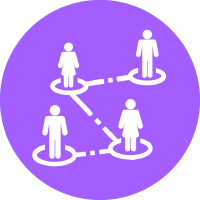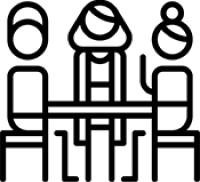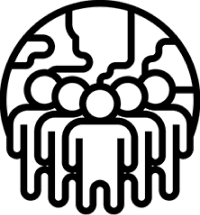EAC and Gender, Community Development & Civil Society Mobilization
The EAC Treaty stresses that regional integration and development should be people-centred and participatory. To this end, broad participation of key stakeholders including women, the youth, private sector and the civil society is needed. Partner States must create an enabling environment for these stakeholders to thrive. Especially women, despite constituting over 60% of the EAC population, are still marginalised in decision-making processes and often have limited access to education, finance, information and communication technologies in comparison to their male counterparts. In order to address these challenges, Partner States have begun enacting and implementing different policies and legal frameworks. EAC-Germany supports the EAC in adopting common approaches towards the inclusive engagement of civil society in the EAC integration process, including marginalised groups such as women, children, youth, elderly and differently abled persons, with the aim of employment creation, poverty reduction, women’s empowerment and improving working conditions.
The German Government supports this EAC Sector under Core Area 1 of EAC-German cooperation as defined by BMZ 2030 – “Sustainable Economic Development, Training and Employment” in the Intervention Area of “Socially and Environmentally Sound Supply Chains, Trade and Sustainable Infrastructure”. The cooperation directly contributes to implement two of the eight priority areas defined by the 6th EAC Development Strategy, namely “Customs Services that Facilitate Legitimate Trade and Investment” and “Awareness Creation”. The BMZ 2030 reform strategy focuses on a new quality of cooperation. More information on BMZ 2030 can be found here.

Gender, Community Development & Civil Society Mobilization
EAC-Germany Support

Gender
Gender equality is a major guiding principle of the EAC for achieving sustainable development. For this reason, gender inclusion is promoted in the EAC integration process. This is of paramount importance for attaining the Community’s broader objective of market-driven and people-centred EAC socio-economic development and integration. Emphasis on gender equality is crucial as it helps the different sectors to draft and implement policies and identify gaps in the legal regime that need to be addressed. It contributes to an inclusive, stable and just development that is based on the protection and promotion of human rights, equal opportunities, non-discrimination, and participation regardless of gender. Finally, it also ensures that the EAC integration process is aligned with the Sustainable Development Goals set by the United Nations in 2015 to achieve a better and more sustainable future for all.Projects:
SEAMPEC II (GIZ)
Objective: Gender equality is promoted throughout the EAC integration process.
Approach: SEAMPEC II supports the participation of women in the economic integration through joint activities with the EAC Secretariat Gender Department. In addition, SEAMPEC II supports advocacy initiatives of private sector organisations that strengthen the economic participation of women entrepreneurs in intra-EAC trade. The programme also facilitated internal mainstreaming measures geared towards strengthening awareness creation on gender equality such as:
- Development of the EAC Gender Policy
- Development of the EAC Gender Barometer
- Establishment of an interactive regional gender platform
- Development of EAC simplified trade guides for women-cross border trader
- Support to the participation of EAC women entrepreneurs in the regional and international trade forum
- Compilation of all recommendations by women entrepreneurs which were taken up for implementation by the EAC Secretariat
Find more information on SEAMPEC II here.

Women Cross-Border Traders
Small-scale, informal cross-border trade within the EAC creates an estimated value of 2 billion USD annually, contributing substantially to the economy of the region. About 80% of it is carried out by women cross-border traders. Most of them are restricted in their activities due to lack of information on trade regulations and safety issues which renders them vulnerable to harassment when crossing border points. This reduces their trading power and income. Still, women engaged in EAC cross-border trade contribute to poverty reduction, improve family welfare as well as income and mitigate the impact of conflict and violence by creating employment, thus enhancing income and food security for their families and communities. Therefore, increased awareness of women in cross-border trade of their rights and their increased participation in trade in the region is crucial for EAC integration and the future economic development. EAC-GIZ specifically focuses on working with women and youth cross-border traders in a bid to break down barriers to their trade and create business opportunities. Through funding grants and creating networks for sharing experiences to help with training and product development, 12,000 women have taken up formal cross-border businesses, overcome cross-border challenges and earned income for their families. Awareness about regional trade procedures and requirements allows them to trade easily and profitably across East Africa.Projects:
GIZ-AUBP (GIZ)
Objective: The AU Member States implement conflict-preventive border governance initiatives - such as the definition of their borders and border cooperation projects - in line with the policies of the AU and RECs.
Approach: Cross-Border Cooperation – The project works with border communities, civil society, local and state actors to implement cross-border cooperation projects at selected borders that are close to their needs and lives Find more information on GIZ-AUBP here.

Youth
The EAC recognizes that youth are a crucial asset, an important key resource and Partner in the socio-economic and political development of the East African Community. The Community has one of the youngest populations in the world, with almost half of the population being under the age of 15, almost one third between the ages of 15 and 24 years and roughly 80% under the age of 35. Young men and women are the main stakeholders and beneficiaries of EAC Initiatives. As the EAC integration widens and deepens, there is growing need to bring the youth on board to engage with them on issues pertinent to regional integration. Hence, their engagement contributes tremendously to the creation of a peaceful, prosperous, and productive region. In this regard, the EAC has been undertaking various initiatives to continuously promote dialogue among the youth and their participation in attaining the Community’s broader objective of market-driven and people-centered EAC socio-economic development and integration. The EAC Youth Policy applies the principles of leave no one behind and inclusivity, it provides a binding framework for effective implementation, monitoring and evaluation of youth programmes and projects as well as clear strategies in the sector and a strategic plan, which considers youth issues.Projects:
SEAMPEC II (GIZ)
Objective: Youth engagement is promoted throughout the EAC integration process.
Approach: SEAMPEC II supports youth-focused activities together with the EAC Secretariat to foster their involvement and engagement in the EAC integration process. Additionally, these supported initiatives contribute to providing the youth an enabling environment and capabilities to capitalise on the opportunities given to them. Youth activities in the programme include:
• Support towards awareness creation to private sector youth on the opportunities and benefits of trading under the AfCFTA. • Support to the participation of youth SMEs in regional and in the intra-Africa exhibitions/fairs, dialogues, and capacity development interventions. • Support to youth as multipliers to communicate socio-economic benefits and successes of regional integration in all EAC Partner States.
Find more information on SEAMPEC II here.